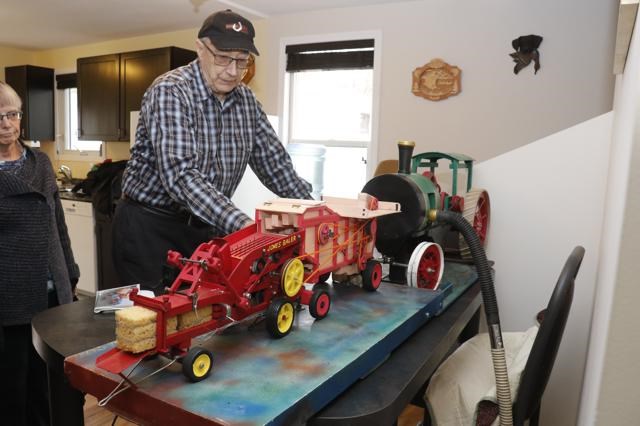Rankin McClean has created toy-sized models of farm equipment out of his memories of growing up in County Donegal in Ireland.
The small machines are not toys, however, but are working models to show how threshing machines, balers and binders worked back in the 1940s and 50s to thresh grain.
The Saskatoon resident was visiting a friend in Weyburn recently, Al Francis, and set them up to show how they worked, and explain how he made the models with intricate detail, sometimes using pieces of household appliances or devices, pieces of Meccano toys or pieces that he had to manufacture on his own.
The main display had a large steam tractor using an engine he created to work on air supplied by a vacuum cleaner in reverse. The tractor was hooked up by a belt to the threshing machine, and a baler was attached to the end.
McClean also had a model of a binder, which he operated with a small motor, but admitted he wasn’t quite finished making it. The first binders had a five-foot width for the blades, then six-foot and later eight-foot.
The small binders were made for the smaller farms found in Ireland which had stone walls and odd corners, and also for old, small fields in Ontario or the Eastern U.S.
The motor for his model was from a car’s power seat, using a fan from a computer to cool it off, explained McClean.
His thresher machine can also be hooked up to a model of a Fordson Major tractor, which was also a popular tractor in use in Ireland, as was the Fordson Dexta, a smaller tractor. His model of a Fordson Major was hand-carved out of wood
The thresher machine is based on the Garvie model found in Ireland, which has a different design than what was used by a North American maker such as Case or McCormick.
One design difference is that the grain came out the front of the thresher nearest the tractor to fill grain bags, rather than through an auger into a grain truck or wagon off to the side.
There was also a difference in the timing of the threshing, compared to how it was done in Western Canada.
“They didn’t thresh the grain at harvest. They hauled the grain home to their yards and stacked them, and during the winter they would thresh it. Nobody had room to store all that grain,” said McClean, adding that threshing crews would visit from farm to farm to do the threshing.
He also noted a very small but highly-useful invention for farmers was the development of the three-point hitch, as “this was what made tractors useful.”
Due to the different design of the threshing machine also, they were not fed in like with a Case thresher on a conveyor, but had to have to strings cut on the sheaves, and the grain had to be fed in at the top so it wouldn’t plug up the machine. The grain came out below into bags, and the straw went out the back and was baled by a square baler.
McClean had a cousin who had a Fordson Major tractor and died in a farm accident, so he made the tractor model as a way to remember him.
“I had never made anything in my life before,” he said, as he set out to carve the tractor body, and then made a wooden engine that could be powered by air from a vacuum cleaner. He created the body of an old steam tractor to house the engine, and one thing led to another as he moved on to the thresher and baler, and most recently the binder.
The air engine was built to run on four pounds of air pressure, which enables it to run at 200 rpm.
McClean created two sets of threshers and balers over the period of three winters, and aims to finish off his binder in the coming months.
He manufactured some parts as he couldn’t find them on anything else, while he was able to scavenge things like the wheels from the tray in a dishwasher and the shifter from a 10-speed bike as two examples. For the binder, some of the parts were from a Meccano toy set that he had to order in from Britain.
McClean came to Canada in 1963, and after working on farms in Ontario and then out West, he became a truck driver for Kindersley Transport, and boarded with Francis’s parents at Kindersley, and became a family friend.



